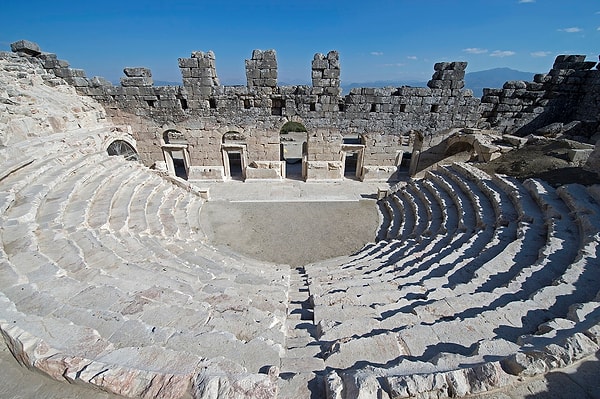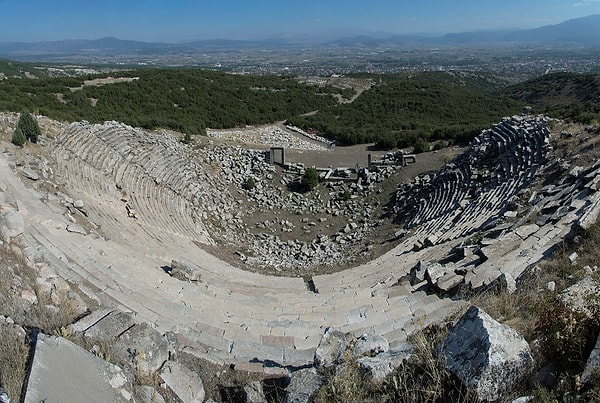Travel Guide to Kibyra: Explore the Forgotten Ancient City of Turkey
If you are looking for a unique journey where history and nature are intertwined, Kibyra Ancient City is for you. Located in the Gölhisar district of Burdur, this impressive ancient city is waiting to be discovered with its huge Roman stadium, unique Medusa mosaic and magnificent structures. In a peaceful atmosphere away from the crowds, you can both get acquainted with the archaeological ruins and discover the hidden treasures of the Lakes Region. In this detailed travel guide, you can find answers to all your questions such as how to get to Kibyra, which buildings to see, entrance hours and ticket information.
History and Foundation of Kibyra

The ancient city of Kibyra dates back to the 3rd century BC. It is thought that the city was founded by the Lydians. However, Kibyra, which experienced its golden age during the Roman Period, gained great importance in terms of military and trade during this period, and even hosted one of the most important gladiator schools in Anatolia.
While Kibyra was located in the province of Asia under the Roman Empire, it was heavily damaged by a major earthquake in 23 AD and was rebuilt with the support of Emperor Tiberius. After this aid, the city was given the title of “Caesarea Kibyra”. With the dissolution of the Roman Empire, the city gradually lost its importance and was abandoned over time.
Cultural and Mythological Importance

Kibyra stands out not only for its military and commercial aspects, but also for its cultural structure. This multicultural city, where four languages (Lydian, Solymian, Pisidian and Greek) were spoken, was one of the important intellectual centres of Anatolia in ancient times.
Although there are not many direct traces of mythological stories in the city, the gladiatorial culture and the stadium scene keep alive the themes of war and heroism of Roman mythology. The buildings in Kibyra are adorned with reliefs and decorations of Roman gods and goddesses, opening the door to the mythological world of the period.
Must-See Buildings in the Ancient City

The ancient city of Kibyra has some of the best-preserved Roman buildings in Anatolia. The main structures you should definitely see during your visit are as follows:
Stadium: It is one of the largest ancient stadiums in Anatolia with a capacity of approximately 10,400 people. This area, where gladiator fights were held, is quite intact today.
Odeion: This building, which attracts attention with its capacity of 3,600 people, was used both as a concert hall and a parliament building. The floor of the Odeion is covered with a Medusa mosaic consisting of 540 thousand small stone pieces. This mosaic is both artistically unique and one of the rare examples of a well-preserved mosaic.
Agora: It is the heart of trade. Surrounded by long columned galleries, the agora was the centre of social life.
The Theatre: It is a large Roman theatre with a capacity of about 8,000 people. It attracts attention with its acoustics.
Bath Complex: It is a large structure bearing the traces of Roman bath culture and is important for understanding the water infrastructure of the city.
Basilica and Necropolis Area: The religious and burial structures of the city are among the other important ruins to be seen.
How to get to Kibyra?

Kibyra Ancient City is located within the borders of Horzum Neighbourhood of Gölhisar district of Burdur. There are several different alternatives for transportation to the region:
By private vehicle: It is approximately 110 km from the Burdur city centre. It is 150 km from Antalya and 100 km from Denizli. After reaching Gölhisar, Kibyra direction signs will take you directly to the site.
By public transportation: It is possible to reach Gölhisar by minibuses departing from Burdur or Denizli bus stations. From Gölhisar to Kibyra, you can take a taxi or walk (about 3 km).
Along the way, the views of the mountains and the highland air will make your journey enjoyable.
Visit Information

Kibyra Ancient City is open to visitors under the Ministry of Culture and Tourism. An entrance fee is charged; the Museum Card is valid. During the summer months, it can be visited from 08.30 in the morning until 19.00 in the evening. Hours may vary during winter.
During the visit, shoes suitable for walking should be preferred, and in summer, a hat and water should be taken to protect from the sun. It is important to be prepared as there is limited shade in the area.
What to do in Kibyra?
Kibyra doesn't only offer seeing historical ruins. It also has an atmosphere where you can be alone with nature, where history and green meet.
You can sit on the theatre steps and watch the view overlooking the Gölhisar Plain.
For photography enthusiasts, the Medusa mosaic, stadium arches and agora offer great shots.
It is an ideal place for a quiet ancient city experience away from the crowds.
Other Places to Visit in the Surroundings

While you have come to Kibyra, there are also points worth exploring around it:
Insuyu Cave (about 90 km): Turkey's first cave opened to tourism and is located in the centre of Burdur.
Salda Lake (about 60 km): Famous for its white beaches and turquoise waters, it is a natural wonder with a Mars-like geological structure.
Sagalassos Ancient City (about 140 km): Located in the Aglasun district of Burdur and known for its magnificent Antonine Fountain.
Burdur Archaeology Museum: Some artefacts excavated from Kibyra are exhibited here.
Source: Kültür Portalı
Accommodation and Dining

Accommodation around Kibyra is limited, but there are a few pensions and boutique hotels in the Gölhisar district centre. For more options, Burdur or Denizli city centres can be preferred.
As for food and drink, local restaurants and pancake places in Gölhisar offer traditional Turkish cuisine. Especially local flavours such as Burdur shish, poppy seed bread and walnut doughnuts can be tried.
Keşfet ile ziyaret ettiğin tüm kategorileri tek akışta gör!

Send Comment